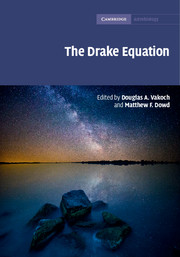Book contents
- The Drake EquationEstimating the Prevalence of Extraterrestrial Life through the Ages
- Cambridge Astrobiology
- The Drake Equation
- Copyright page
- Dedication
- Contents
- Contributors
- Foreword
- Preface
- Book part
- Introduction
- 1 Rate of formation of stars suitable for the development of intelligent life, R*, pre-1961
- 2 Rate of formation of stars suitable for the development of intelligent life, R*, 1961 to the present
- 3 Fraction of stars with planetary systems, fp, pre-1961
- 4 Fraction of stars with planetary systems, fp, 1961 to the present
- 5 Number of planets, per solar system, with an environment suitable for life, ne, pre-1961
- 6 Number of planets, per solar system, with an environment suitable for life, ne, 1961 to the present
- 7 Fraction of suitable planets on which life actually appears, fl, pre-1961
- 8 Fraction of suitable planets on which life actually appears, fl, 1961 to the present
- 9 Fraction of life-bearing planets on which intelligent life emerges, fi, pre-1961
- 10 Fraction of life-bearing planets on which intelligent life emerges, fi, 1961 to the present
- 11 Fraction of civilizations that develop a technology that releases detectable signs of their existence into space, fc, pre-1961
- 12 Fraction of civilizations that develop a technology that releases detectable signs of their existence into space, fc, 1961 to the present
- 13 Length of time such civilizations release detectable signals into space, L, pre-1961
- 14 Length of time such civilizations release detectable signals into space, L, 1961 to the present
- Afterword
- Index
- References
13 - Length of time such civilizations release detectable signals into space, L, pre-1961
Published online by Cambridge University Press: 05 July 2015
- The Drake EquationEstimating the Prevalence of Extraterrestrial Life through the Ages
- Cambridge Astrobiology
- The Drake Equation
- Copyright page
- Dedication
- Contents
- Contributors
- Foreword
- Preface
- Book part
- Introduction
- 1 Rate of formation of stars suitable for the development of intelligent life, R*, pre-1961
- 2 Rate of formation of stars suitable for the development of intelligent life, R*, 1961 to the present
- 3 Fraction of stars with planetary systems, fp, pre-1961
- 4 Fraction of stars with planetary systems, fp, 1961 to the present
- 5 Number of planets, per solar system, with an environment suitable for life, ne, pre-1961
- 6 Number of planets, per solar system, with an environment suitable for life, ne, 1961 to the present
- 7 Fraction of suitable planets on which life actually appears, fl, pre-1961
- 8 Fraction of suitable planets on which life actually appears, fl, 1961 to the present
- 9 Fraction of life-bearing planets on which intelligent life emerges, fi, pre-1961
- 10 Fraction of life-bearing planets on which intelligent life emerges, fi, 1961 to the present
- 11 Fraction of civilizations that develop a technology that releases detectable signs of their existence into space, fc, pre-1961
- 12 Fraction of civilizations that develop a technology that releases detectable signs of their existence into space, fc, 1961 to the present
- 13 Length of time such civilizations release detectable signals into space, L, pre-1961
- 14 Length of time such civilizations release detectable signals into space, L, 1961 to the present
- Afterword
- Index
- References
Summary
This chapter is an overview of the prehistory of L, how people across the globe from our earliest sources to 1961 have tried to understand the beginning and end of history, and the rise and fall of civilizations. Factor L is put into a longer historical context of human conceptions about history, time, and civilization. In focus is the question of how it was possible to formulate L in its modern version, as embodied in the Drake Equation. This was not possible, I argue, until the end of the nineteenth century. L required a number of philosophical, scientific, and technical discoveries and inventions before it became possible to discuss the longevity of extraterrestrial technical civilizations. Of special significance was the “discovery of time,” the emergence of a set of ideas for understanding human temporality: first, linear time, time that has a beginning and an end, and in which nothing is forever; second, long time lines, in which there was a time before humans and human civilization, and that the history of our civilization is only a fraction of the history of universe; and third, that time has a direction, that humans are historical beings – that is, knowledge, culture, and society are not something preexisting but something created by humans, evolving, that rests on the experiences and actions of previous generations in a cumulative process leading to the development of knowledge, behavior, and life conditions, or what is sometimes called the “idea of progress.”
The first section concerns the beginning of time: notions of the dawn and age of the world, thoughts about the history of the Earth and humankind, when humans entered the history of the universe, and the emergence of the notion that human civilization has existed for only a fraction of the total age of the universe. The second section concerns the direction of time: where we are heading, ideas about how societies emerge, the rise of civilizations, and the notion of advancement, the thought that civilization is not a given but something created by humans. The third section puts forward notions of the end of time: doom, cataclysms, the meaning of history, and how and why civilizations and empires – or the whole world – fall. Finally, I conclude that L is a measure of the civilizing or socialization process, and the variables that underlie it: biocultural coevolution and the interaction between the evolution of cognition and socialization.
- Type
- Chapter
- Information
- The Drake EquationEstimating the Prevalence of Extraterrestrial Life through the Ages, pp. 241 - 269Publisher: Cambridge University PressPrint publication year: 2015

